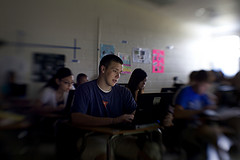Leveraging Student Laptops and Smart Phones – Highlights from the Conversation
 Last week, the CFT hosted a conversation on teaching titled “Wireless in the Classroom: Strategies for Leveraging Student Laptops and Smart Phones.” This session, a follow-up to our earlier session focusing on policies on laptops use in the classroom, offered instructors interested in taking advantage of classroom Wifi and student mobile devices some ideas for doing so.
Last week, the CFT hosted a conversation on teaching titled “Wireless in the Classroom: Strategies for Leveraging Student Laptops and Smart Phones.” This session, a follow-up to our earlier session focusing on policies on laptops use in the classroom, offered instructors interested in taking advantage of classroom Wifi and student mobile devices some ideas for doing so.
Panelist Ken Debelak (Chemical & Biomolecular Engineering) described the School of Engineering’s laptop initiative, the TransIT program. He brought with him some mobile computers of the past, slide rules and handheld calculators, noting that the computational power available to students in laptops and (soon) smart phones means that they’re able to solve interesting engineering problems not previously possible to solve. This, in turn, allows Ken and other engineering instructors to focus their efforts on developing students’ mental models of important engineering concepts and systems. The line between lecture and lab has blurred thanks to the laptop initiative, with engineering students using class time to “play” with computational tools. By exploring parameters within models and simulations, students develop the conceptual understand that complements their computational skills.
Jamie Pope (Nursing) was our second panelist. She teaches a large (150-student) nutrition class for undergraduates. Although she doesn’t have a laptop requirement in her class, between one-third and one-half of her students bring laptops on any given day. She posts her lecture slides to her course’s OAK site before class so that students can follow along on their laptops and click through the links she provides in those slides to visit relevant websites during class.
Jamie said that there’s no way her students can learn everything there will ever be to know about nutrition in her class, so she teaches her students how to find and evaluate the quality of sources of nutritional information. For example, she’ll briefly describe a particular dietary supplement, then have her students work in groups (where each group has at least one laptop) to find information online about that supplement. She’ll tell some groups to limit their search to .com websites, others to focus on .org websites, and the rest to search for .gov sites. Then she’ll have her students compare the nature of the information they find on these various kinds of sites.
Our third panelist was Betsy Kennedy, also from the School of Nursing. She described her use of ResponseWare, a system that allows her students to respond to multiple-choice and fill-in-the-blank questions she poses to them during class using their laptops and smart phones. This classroom response system is an alternative to the clickers used in undergraduate education at Vanderbilt. She finds that her students all have Web-enabled devices of various kinds, and the ResponseWare student license costs less than a clicker device.
Betsy appreciates the interaction and engagement she can foster by asking and discussing ResponseWare questions during class. She finds the system particularly helpful in test review sessions, since the feedback in provides helps her make good use of her time. When students answer a question mostly correctly, she can quickly move on. When many students miss a question, it’s a sign she needs to spend more time on that topic. She also uses the system to help her students prepare for their nursing licensing exams, which feature difficult multiple-choice questions.
See our earlier blog post for links to resources shared during the session, including resources for using Twitter and Google Moderator as tools for backchannel discussions during class.

Leave a Response